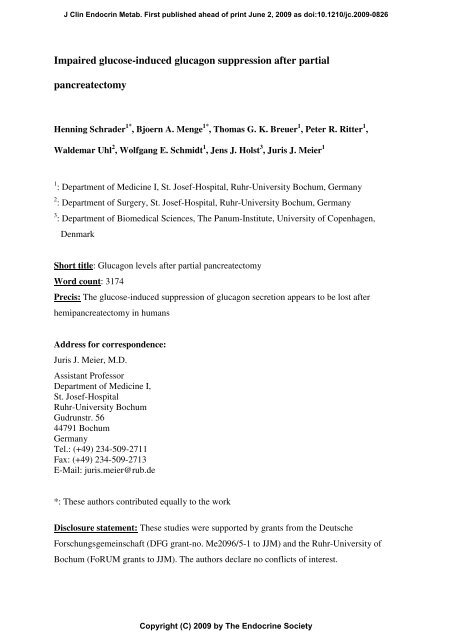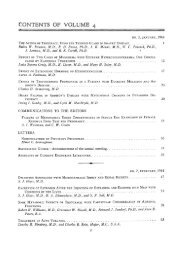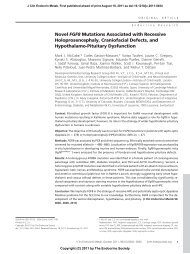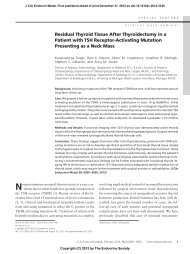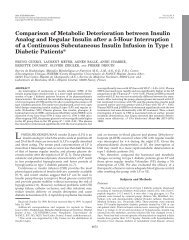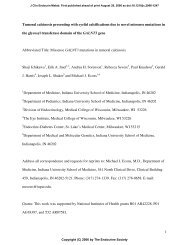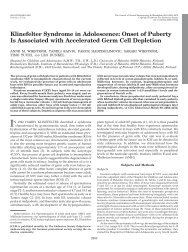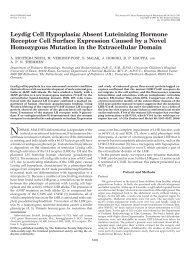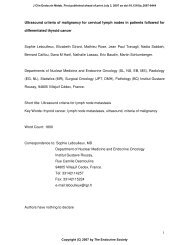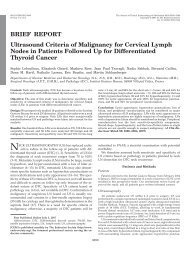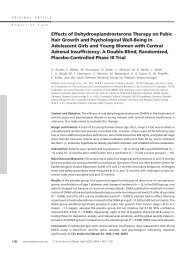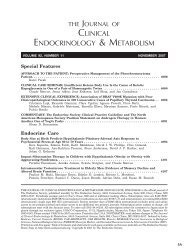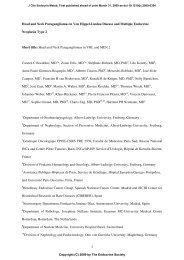Impaired glucose-induced glucagon suppression after partial ...
Impaired glucose-induced glucagon suppression after partial ...
Impaired glucose-induced glucagon suppression after partial ...
Create successful ePaper yourself
Turn your PDF publications into a flip-book with our unique Google optimized e-Paper software.
J Clin Endocrin Metab. First published ahead of print June 2, 2009 as doi:10.1210/jc.2009-0826<br />
<strong>Impaired</strong> <strong>glucose</strong>-<strong>induced</strong> <strong>glucagon</strong> <strong>suppression</strong> <strong>after</strong> <strong>partial</strong><br />
pancreatectomy<br />
Henning Schrader 1* , Bjoern A. Menge 1* , Thomas G. K. Breuer 1 , Peter R. Ritter 1 ,<br />
Waldemar Uhl 2 , Wolfgang E. Schmidt 1 , Jens J. Holst 3 , Juris J. Meier 1<br />
1<br />
: Department of Medicine I, St. Josef-Hospital, Ruhr-University Bochum, Germany<br />
2<br />
: Department of Surgery, St. Josef-Hospital, Ruhr-University Bochum, Germany<br />
3<br />
: Department of Biomedical Sciences, The Panum-Institute, University of Copenhagen,<br />
Denmark<br />
Short title: Glucagon levels <strong>after</strong> <strong>partial</strong> pancreatectomy<br />
Word count: 3174<br />
Precis: The <strong>glucose</strong>-<strong>induced</strong> <strong>suppression</strong> of <strong>glucagon</strong> secretion appears to be lost <strong>after</strong><br />
hemipancreatectomy in humans<br />
Address for correspondence:<br />
Juris J. Meier, M.D.<br />
Assistant Professor<br />
Department of Medicine I,<br />
St. Josef-Hospital<br />
Ruhr-University Bochum<br />
Gudrunstr. 56<br />
44791 Bochum<br />
Germany<br />
Tel.: (+49) 234-509-2711<br />
Fax: (+49) 234-509-2713<br />
E-Mail: juris.meier@rub.de<br />
*: These authors contributed equally to the work<br />
Disclosure statement: These studies were supported by grants from the Deutsche<br />
Forschungsgemeinschaft (DFG grant-no. Me2096/5-1 to JJM) and the Ruhr-University of<br />
Bochum (FoRUM grants to JJM). The authors declare no conflicts of interest.<br />
Copyright (C) 2009 by The Endocrine Society
Abstract<br />
Introduction: The <strong>glucose</strong>-<strong>induced</strong> decline in <strong>glucagon</strong> levels is often lost in patients with<br />
type 2 diabetes. It is unclear whether this is due to an independent defect in alpha-cell<br />
function or secondary to the impairment in insulin secretion. We examined whether a <strong>partial</strong><br />
pancreatectomy in humans would also impair post-challenge <strong>glucagon</strong> concentrations, and if<br />
so, whether this could be attributed to the reduction in insulin levels.<br />
Patients and methods: 36 patients with pancreatic tumours or chronic pancreatitis were<br />
studied before and <strong>after</strong> ~50% pancreatectomy with a 240 min oral <strong>glucose</strong> challenge, and<br />
the plasma concentrations of <strong>glucose</strong>, insulin, C-peptide, and <strong>glucagon</strong> were determined.<br />
Results: Fasting and post-challenge insulin and C-peptide levels were significantly lower<br />
<strong>after</strong> <strong>partial</strong> pancreatectomy (p < 0.0001). Likewise, fasting <strong>glucagon</strong> concentrations tended to<br />
be lower <strong>after</strong> the intervention (p = 0.11). Oral <strong>glucose</strong> ingestion elicited a decline in<br />
<strong>glucagon</strong> concentrations before surgery (p < 0.0001), but this was lost <strong>after</strong> <strong>partial</strong><br />
pancreatectomy (p < 0.01 vs. pre OP values). The loss of <strong>glucose</strong>-<strong>induced</strong> <strong>glucagon</strong><br />
<strong>suppression</strong> was found <strong>after</strong> both pancreatic head (p < 0.001) and tail (p < 0.05) resection.<br />
The <strong>glucose</strong>-<strong>induced</strong> changes in <strong>glucagon</strong> levels were closely correlated to the respective<br />
increments in insulin and C-peptide concentrations (p < 0.01).<br />
Conclusions: The <strong>glucose</strong>-<strong>induced</strong> <strong>suppression</strong> in <strong>glucagon</strong> levels is lost <strong>after</strong> a 50% <strong>partial</strong><br />
pancreatectomy in humans. This suggest that impaired alpha-cell function in patients with<br />
type 2 diabetes may also be secondary to reduced beta-cell mass. Alterations in <strong>glucagon</strong><br />
regulation should be considered as a potential side effect of <strong>partial</strong> pancreatectomies.<br />
2
Introduction:<br />
In health, <strong>glucose</strong> homoeostasis is tightly regulated by the interplay of insulin and <strong>glucagon</strong><br />
secretion from pancreatic islets (1). Thus, under conditions of prolonged fasting, <strong>glucagon</strong><br />
levels rise, enhancing hepatic glycogenolysis and gluconeogenesis, whereas oral or<br />
intravenous <strong>glucose</strong> administration typically results in a decline in <strong>glucagon</strong> levels (2, 3).<br />
Furthermore, a brisk increase in <strong>glucagon</strong> secretion in response to falling blood <strong>glucose</strong><br />
concentrations provides a safeguard against the development of hypoglycaemia (2, 3).<br />
Alterations in <strong>glucagon</strong> secretion are frequently found in patients with type 2 diabetes (4).<br />
Thus, an insufficient <strong>suppression</strong> of <strong>glucagon</strong> levels <strong>after</strong> oral <strong>glucose</strong> or meal ingestion is<br />
thought to contribute significantly to the excessive hepatic <strong>glucose</strong> production in type 2<br />
diabetic patients (2, 5-7). Such abnormalities in <strong>glucagon</strong> secretion have been reported not<br />
only in patients with overt diabetes, but even in pre-diabetic subjects, such as individuals with<br />
impaired <strong>glucose</strong> tolerance (IGT) (8). However, the aetiology of these defects in <strong>glucagon</strong><br />
secretion is less clear, and two different explanations have been expounded. 1) The lack of<br />
<strong>glucose</strong>-<strong>induced</strong> <strong>suppression</strong> of <strong>glucagon</strong> levels in type 2 diabetes could represent a primary,<br />
possibly genetically determined, defect in alpha-cell function, independent of other metabolic<br />
abnormalities in such patients (9, 10). Such argumentation would imply that defects in<br />
<strong>glucagon</strong> secretion predispose subjects to developing type 2 diabetes (11). Against this, we<br />
and others have failed to detect any defects in alpha-cell function in individuals at high risk<br />
for developing type 2 diabetes, such as first-degree relatives (12, 13). 2) Alternatively, the<br />
lack of <strong>glucose</strong>-<strong>induced</strong> <strong>suppression</strong> of <strong>glucagon</strong> levels in patients with type 2 diabetes may<br />
be secondary to the deficit in beta-cell mass and the overall reduction in insulin secretion in<br />
such patients (14-16). In line with this hypothesis, a selective 50% reduction in beta-cell mass<br />
<strong>induced</strong> by the beta cytotoxin, alloxan, led to the development of both fasting and<br />
postprandial hyper<strong>glucagon</strong>aemia in Göttingen minipigs (17). Several experiments have<br />
suggested a close interaction of alpha- and beta-cells at the individual islet level (14-16).<br />
3
However, this does not exclude that systemic insulin concentrations would have an impact on<br />
<strong>glucagon</strong> release as well. Therefore, in the present study, we examined the effects of a hemi-<br />
pancreatectomy, leading to a ~50% reduction in both beta- and alpha-cell mass, on post-<br />
challenge <strong>glucagon</strong> levels in humans. For these purposes, 36 patients undergoing pancreatic<br />
surgery were studied before and <strong>after</strong> surgery. By these means, we addressed the questions:<br />
(1) Is the <strong>glucose</strong>-<strong>induced</strong> <strong>suppression</strong> of <strong>glucagon</strong> levels impaired <strong>after</strong> hemi-pancreatectomy<br />
in humans, and if so, (2) are the alterations in <strong>glucose</strong>-<strong>induced</strong> <strong>glucagon</strong> <strong>suppression</strong> related<br />
to the respective changes in glycaemia or insulin secretion?<br />
4
Materials and methods<br />
Study design<br />
A total of 36 patients undergoing pancreatic surgery for chronic pancreatitis, pancreatic<br />
carcinoma, and benign pancreatic tumours were studied. All patients were examined before<br />
and <strong>after</strong> pancreatic surgery with a 240 min oral <strong>glucose</strong> challenge, and the respective changes<br />
in the plasma concentration profiles of <strong>glucose</strong>, insulin, C-peptide, and <strong>glucagon</strong> were<br />
determined. Parts of this study related to the changes in <strong>glucose</strong>, insulin and C-peptide levels<br />
<strong>after</strong> <strong>partial</strong> pancreatectomy have been communicated in a separate report (18). The study<br />
protocol was approved by the ethics committee of the Ruhr-University Bochum (registration<br />
number 2528). All patients provided written informed consent prior to study enrolment.<br />
Patients:<br />
A total of 36 patients (18 males, 18 females) undergoing pancreatic resections in the<br />
Department of Surgery, St. Josef-Hospital, Ruhr-University Bochum, between the years 2004<br />
and 2007 were included. One patient from the original cohort (18) was excluded, because<br />
<strong>glucagon</strong> measurements were not available. The mean age of the patients was 59.4 ± 13.0<br />
years, and the body mass index was 23.9 ± 4.2 kg/m 2 . Detailed patient characteristics have<br />
previously been reported (18). 14 patients were undergoing surgery for chronic pancreatitis,<br />
nine patients were treated for pancreatic adenocarcinoma, 12 patients underwent surgery for<br />
the removal of benign pancreatic adenomas, and one patient was undergoing surgery for<br />
because of a tumour of the papilla Vateri.<br />
In 12 patients, distal pancreatectomies (pancreas tail resection) were performed, whereas<br />
24 patients were treated with a proximal pancreatectomy (pancreas head resection). The latter<br />
group comprised 17 patients undergoing pancreaticoduodenectomy with pylorus preservation,<br />
6 patients undergoing duodenum-preserving pancreatic head resections according to Beger,<br />
and one patient undergoing classic <strong>partial</strong> pancreaticoduodenectomy (Whipple’s operation).<br />
5
The clinical diagnoses chronic pancreatitis, pancreatic carcinoma, pancreatic adenoma or<br />
ampullary cancer were confirmed by an independent pathologist in all cases. All post-<br />
operative experiments were conducted <strong>after</strong> full clinical recovery of the patients. The mean<br />
time interval between the first oral <strong>glucose</strong> challenge and surgery was 8.6 ± 7.6 days, and the<br />
second test was carried out 23.9 ± 27 days <strong>after</strong> surgery.<br />
Experimental procedures<br />
The experiments were performed as described (18) in the morning <strong>after</strong> an overnight fast with<br />
subjects in a supine position throughout the experiments. Both ear lobes were made<br />
hyperemic using Finalgon � (Nonivamid 4 mg/g, Nicoboxil 25 mg/g). The experiments were<br />
started by the ingestion of the oral <strong>glucose</strong> load (75 g <strong>glucose</strong> in 300 ml) over 5 min, and<br />
capillary and venous blood samples were drawn at t = -5, 0, 15, 30, 60, 90, 120, 150, 180,<br />
210, and 240. Capillary blood samples (approximately 100 μl) were added to NaF (Microvette<br />
CB 300; Sarstedt, Nümbrecht, Germany) for the immediate measurement of <strong>glucose</strong>. Venous<br />
blood was drawn into chilled tubes containing EDTA and aprotinin (Trasylol � ; 20000<br />
KIU/ml, 200 μl per 10 ml blood; Bayer AG, Leverkusen, Germany) and kept on ice. After<br />
centrifugation at 4 °C, plasma for hormone analyses was kept frozen at -28 °C.<br />
Measurements<br />
Glucose was measured as described (18, 19) using a <strong>glucose</strong> oxidase method with a Glucose<br />
Analyser 2 (Beckman Instruments, Munich, Germany).<br />
Insulin was measured as described (18) using an insulin microparticle enzyme<br />
immunoassay (MEIA), IMx Insulin, Abbott Laboratories, Wiesbaden, Germany. Cross-<br />
reactivity with proinsulin was < 0.005%. The intra-assay coefficient of variation was 4 %.<br />
C-peptide was measured as described (18) using an enzyme-linked immunoabsobent<br />
6
assay (ELISA) from DAKOP Ltd., Cambrigshire, UK. Intra-assay coefficient of variation was<br />
3.3 to 5.7 %, inter-assay variation was 4.6 to 5.7 %. Human insulin and C-peptide were used<br />
as standards.<br />
IR-<strong>glucagon</strong> was measured by a radioimmunoassay using antibody no. 4305 in ethanol-<br />
extracted plasma, as described (20). The detection limit was < 1 pmol/l. Intra-assay<br />
coefficient of variation was below 6.7 %. This assay specifically reacts with the free<br />
unmodified C-terminus of the <strong>glucagon</strong> molecule. Therefore, it is theoretically possible that<br />
other circulating forms <strong>glucagon</strong> than the 3500 dalton <strong>glucagon</strong> (especially pro<strong>glucagon</strong> 1-61)<br />
were detected as well. However, the quantitative contribution of these forms to the overall<br />
<strong>glucagon</strong> immunoreactivity appears to be rather negligible (21).<br />
Calculations:<br />
The Matsuda index of insulin sensitivity and HOMA insulin resistance were calculated as<br />
described (22, 23). The maximum <strong>glucose</strong>-<strong>induced</strong> <strong>suppression</strong> of <strong>glucagon</strong> levels was<br />
calculated by expressing the nadir <strong>glucagon</strong> levels between t = 15 min and t = 240 min in<br />
relation to the respective baseline levels.<br />
Statistical Analysis<br />
Subject characteristics are reported as mean ± SD, results are presented as mean ± SEM. Time<br />
course evaluations were carried out by paired or unpaired analysis of variance (ANOVA), as<br />
appropriate, using Statistica version 5.0 (Statsoft Europe, Hamburg, Germany). All other<br />
parameters were compared by two-way ANOVA or Student’s t-test, as appropriate. A p-value<br />
< 0.05 was taken to indicate significant differences. Regression analyses were carried out<br />
using GraphPad Prism 4.<br />
7
Results<br />
Fasting <strong>glucose</strong> concentrations increased significantly <strong>after</strong> <strong>partial</strong> pancreatectomy, but the<br />
immediate rise in post-challenge <strong>glucose</strong> excursions was lower following the intervention (p <<br />
0.0001; Fig. 1A; (18)). This was accompanied by significant reduction in both fasting and<br />
post-challenge insulin and C-peptide levels (p < 0.0001; Fig. 1B, D; (18)). There was also a<br />
significant improvement in the Matsuda index of insulin sensitivity (6.8 ± 0.6 to 8.6 ± 0.6, p =<br />
0.005), whereas HOMA IR was unchanged (1.7 ± 0.2 vs. 1.6 ± 0.1, p = 0.35).<br />
Fasting <strong>glucagon</strong> levels tended to be lower <strong>after</strong> <strong>partial</strong> pancreatectomy (p = 0.11). Oral<br />
<strong>glucose</strong> ingestion elicited a significant decline in <strong>glucagon</strong> concentrations in the experiments<br />
carried out prior to surgery (p < 0.0001; Fig. 1C). Thus, the maximum <strong>suppression</strong> of<br />
<strong>glucagon</strong> levels from baseline was -39 ± 3 % before and -22 ± 4 % <strong>after</strong> surgery (p = 0.0017).<br />
Similarly, the difference between the mean <strong>glucagon</strong> concentrations <strong>after</strong> <strong>glucose</strong> ingestion<br />
and baseline values (� <strong>glucagon</strong>) was markedly reduced <strong>after</strong> surgery (p < 0.01; Fig 2).<br />
In order to determine, whether the impairment in <strong>glucose</strong>-<strong>induced</strong> <strong>glucagon</strong> <strong>suppression</strong><br />
<strong>after</strong> <strong>partial</strong> pancreatectomy was secondary to the development of hyperglycaemia or rather<br />
due to the reduction in insulin secretion, the <strong>glucose</strong>-<strong>induced</strong> reductions in <strong>glucagon</strong><br />
concentrations were correlated to the respective <strong>glucose</strong>, insulin and C-peptide levels. There<br />
was indeed a significant relationship between the increments in insulin and C-peptide levels<br />
<strong>after</strong> the <strong>glucose</strong> load and both the mean changes in <strong>glucagon</strong> levels <strong>after</strong> the <strong>glucose</strong> load (�<br />
<strong>glucagon</strong>) (Fig. 3). Interestingly, the associations of <strong>glucagon</strong> levels with insulin levels were<br />
greater than with C-peptide concentrations. In contrast, neither the fasting <strong>glucose</strong> levels (r =<br />
0.21, p = 0.081), nor the mean post-challenge <strong>glucose</strong> concentrations (r = 0.023, p = 0.85)<br />
were related to the mean <strong>glucose</strong>-<strong>induced</strong> changes in <strong>glucagon</strong> levels (details not shown).<br />
When the patients were grouped according to the respective sort of pancreatic resection,<br />
the impairment in <strong>glucose</strong>-<strong>induced</strong> <strong>suppression</strong> of <strong>glucagon</strong> levels was apparent <strong>after</strong> both<br />
pancreatic head (n = 24; p < 0.001; Fig. 4A) and tail (n = 12; 0 < 0.05; Fig. 4B) resection.<br />
8
However, <strong>after</strong> pancreatic head resection fasting <strong>glucagon</strong> concentrations were almost<br />
unchanged, whereas the post-operative <strong>glucagon</strong> concentrations were even higher compared<br />
to pre-operative levels from t = 90 to 150 min <strong>after</strong> the <strong>glucose</strong> drink. In contrast, pancreatic<br />
tail resection caused an ~45% reduction in fasting <strong>glucagon</strong> levels, and postoperative<br />
<strong>glucagon</strong> levels remained lower than before surgery at all subsequent time points <strong>after</strong> the<br />
<strong>glucose</strong> drink.<br />
Moreover, the individual impact of the hemipancreatectomy on <strong>glucagon</strong> concentrations<br />
seemed to differ to some extent between the different groups of patients studied. Thus, in<br />
patients undergoing surgery for the removal of pancreatic adenomas or extrapancreatic<br />
tumors, fasting <strong>glucagon</strong> levels were 31% lower <strong>after</strong> surgery, and the <strong>glucose</strong>-<strong>induced</strong><br />
decline in <strong>glucagon</strong> levels was no longer detectable (Fig. 5A). In patients undergoing surgery<br />
for chronic pancreatitis, the overall concentrations of <strong>glucagon</strong> tended to be lower at all time<br />
points compared to the other patient groups, but the impairment in <strong>glucose</strong>-<strong>induced</strong> <strong>glucagon</strong><br />
<strong>suppression</strong> was less apparent (Fig.5B). In patients treated for pancreatic carcinoma, fasting<br />
<strong>glucagon</strong> levels were 23% lower <strong>after</strong> the operation, but post-challenge <strong>glucagon</strong> levels<br />
tended to be even higher (Fig. 5C).<br />
9
Discussion:<br />
<strong>Impaired</strong> <strong>glucagon</strong> <strong>suppression</strong> <strong>after</strong> <strong>glucose</strong> administration is a characteristic hallmark of<br />
type 2 diabetes (2, 4, 5). This has been held to be secondary to the loss of intra-islet insulin<br />
secretion in such patients (4, 14, 16, 17, 24). The present studies were designed to address the<br />
question, whether a 50% <strong>partial</strong> pancreatectomy would alter alpha-cell function in humans as<br />
well. We report that the <strong>glucose</strong>-<strong>induced</strong> decline in <strong>glucagon</strong> concentrations was lost <strong>after</strong><br />
hemi-pancreatectomy. This impairment in alpha-cell function was closely related to the<br />
changes in insulin secretion, but appeared to be independent of the increases in glycaemia.<br />
Even though the maximum secretory capacity of the alpha-cells (e.g. in response to<br />
arginine or hypoglycaemia) has not been tested directly in this study, there was a tendency<br />
towards a reduction in fasting <strong>glucagon</strong> levels, consistent with the expected 50% reduction in<br />
alpha-cell mass. This is in line with previous studies by Seaquist and Robertson<br />
demonstrating an impaired <strong>glucagon</strong> response to i.v. arginine <strong>after</strong> hemi-pancreatectomy in<br />
humans (25). However, although the maximum <strong>glucagon</strong> responses seem to be primarily<br />
determined by the number of alpha-cells within the pancreas, the <strong>glucose</strong>-<strong>induced</strong> decline in<br />
<strong>glucagon</strong> concentrations is largely controlled by other factors. In this regard, macronutrients,<br />
and particularly <strong>glucose</strong> and amino acids, are important regulators (26, 27), but there is also<br />
good evidence that endocrine hormones, such as <strong>glucagon</strong>-like peptide 1 (GLP-1) (28), gastric<br />
inhibitory polypeptide (GIP) (12, 29), gastrin (30), and cholecystokinin (31), may play a role.<br />
In addition to these well established nutrient and endocrine factors, a number of studies have<br />
suggested a paracrine regulation of <strong>glucagon</strong> release (32). Thus, within the individual islets,<br />
the beta-cells are typically located in the core region, whereas the alpha-cells are<br />
predominantly located in the islet periphery. Since the blood flow within the islets is usually<br />
centripetally directed, reaching the beta-cell rich core first, and then traversing into the mantle<br />
region, the islet alpha-cells are being exposed to very high local insulin levels (33), and a<br />
number of in vitro studies have provided evidence for an inhibitory effect of insulin on alpha-<br />
10
cell secretion (34, 35). Consistent with such reasoning, previous studies in baboons and<br />
minipigs have demonstrated a close inverse relationship between circulating insulin and<br />
<strong>glucagon</strong> levels at a minute-by-minute basis (16, 17). Furthermore, selective destruction of<br />
islet beta-cells in Göttingen minipigs has resulted in a loss of meal-<strong>induced</strong> <strong>glucagon</strong><br />
<strong>suppression</strong> and the development of overt hyperglycaemia (17). The present findings extend<br />
these studies by showing that an inverse relationship between insulin and <strong>glucagon</strong> levels can<br />
also be found at a systemic level, independent of the paracrine interaction of both hormones<br />
within the individual islets. Thus, since the intra-islet relationship between alpha- and beta-<br />
cells should not be affected by a hemi-pancreatectomy, the loss of <strong>glucose</strong>-<strong>induced</strong><br />
<strong>suppression</strong> of <strong>glucagon</strong> levels in the present experiments suggests that a general reduction in<br />
systemic insulin levels may impair alpha-cell function as well. Of note, this effect was<br />
apparent <strong>after</strong> both pancreatic head and tail resection. Such argumentation is also consistent<br />
with previous studied by Robertson and colleagues showing elevated post-operative fasting<br />
<strong>glucagon</strong> levels in healthy subjects who donated 50% of their pancreas for transplantation<br />
(36). Taken together, these studies emphasize the importance of circulating insulin levels for<br />
the maintenance of alpha-cell function and lend strong support to the postulate that the<br />
hyper<strong>glucagon</strong>aemia in patients with type 2 diabetes develops as a consequence of the<br />
reduction in beta-cell mass, rather than due to an independent, primary defect in alpha-cell<br />
function. Such reasoning is also in line with the clinical finding that endogenous <strong>glucagon</strong><br />
levels often decline <strong>after</strong> exogenous insulin supplementation in patients with diabetes (37,<br />
38). However, aside from these effects of systemic insulin, a direct paracrine interaction<br />
between insulin and alpha-cells may still exist, as suggested by previous animal studies.<br />
Arguably, the inverse relationship between beta- and alpha-cell secretion may also be<br />
mediated by other secretory products of the beta-cell than just insulin. In this regard, a direct<br />
inhibitory action of zinc on alpha-cell secretion has recently been postulated by some (39),<br />
but not all groups (40). However, while such inhibitory actions of zinc may contribute to the<br />
11
intra-islet inhibition of <strong>glucagon</strong> release, they are less likely to play a role for the impaired<br />
<strong>glucose</strong>-<strong>induced</strong> <strong>suppression</strong> of <strong>glucagon</strong> secretion observed <strong>after</strong> hemipancreatectomy in this<br />
study, where the paracrine regulation of hormone secretion within the individual islets was<br />
not specifically altered.<br />
Moreover, even though the observed relationships between insulin and <strong>glucagon</strong> levels<br />
suggest a direct interaction between both islet hormones, other pancreatic hormones might<br />
have contributed as well. In particular, somatostatin has been previously shown to act both as<br />
a paracrine and endocrine regulator of alpha-cell secretion (41, 42). It is therefore possible<br />
that the reduction in delta-cell mass and secretion <strong>induced</strong> by the hemipancreatectomy has<br />
contributed to the observed impairment in <strong>glucose</strong>-<strong>induced</strong> <strong>glucagon</strong> <strong>suppression</strong>.<br />
Alternatively, one might argue that the lack of <strong>glucagon</strong> <strong>suppression</strong> might have been<br />
secondary to the <strong>partial</strong> removal of the duodenum leading to impaired <strong>glucose</strong>-<strong>induced</strong> GLP-1<br />
secretion. Unfortunately, incretin levels were not determined in this study. However, since<br />
alterations in <strong>glucagon</strong> secretion were found <strong>after</strong> both pancreaticoduodenectomy and <strong>after</strong><br />
pancreatic tail resection (where the duodenum is not affected at all), such explanation appears<br />
less likely.<br />
Although a tendency towards a loss of <strong>glucose</strong>-<strong>induced</strong> <strong>glucagon</strong> <strong>suppression</strong> was<br />
detectable in all groups of patients studied, the reduction in fasting <strong>glucagon</strong> levels was more<br />
pronounced in patients undergoing surgery for the removal of benign adenomas,<br />
extrapancreatic tumours or pancreatic cancer than in patients with chronic pancreatitis. Most<br />
likely this is due to the fact that in patients with chronic pancreatits the secretion of both<br />
insulin and <strong>glucagon</strong> was already markedly abnormal prior to surgery, meaning that the<br />
additional alterations <strong>induced</strong> by the hemipancreatectomy were less apparent than in the other<br />
patient groups (43). Consistent with this, the pre-operative insulin levels and <strong>glucagon</strong> levels<br />
were lowest in patients with chronic pancreatitis (18).<br />
12
A number of previous studies in rats and mice have suggested that functional alterations in<br />
islet secretion are only detectable <strong>after</strong> reductions in beta-cell mass in the range of ~80-90%<br />
(44, 45), whereas less extensive pancreatic resections can be tolerated without measurable<br />
disturbances in circulating islet hormone concentrations (46). These reports are contrasted by<br />
larger animal studies, where alterations in both insulin and <strong>glucagon</strong> secretion occurred<br />
already <strong>after</strong> an ~50% beta-cell loss (15, 17, 47). Furthermore, studies in individuals with<br />
impaired fasting <strong>glucose</strong>, who typically already exhibit defects in insulin secretion (48), have<br />
revealed an ~50% deficit in beta-cell mass even before the full onset of type 2 diabetes (49).<br />
The present studies showing marked alterations in both insulin and <strong>glucagon</strong> secretion <strong>after</strong><br />
hemipancreatectomy are therefore consistent with these previous studies and re-emphasize the<br />
importance of beta-cell mass for the maintenance of <strong>glucose</strong> homoeostasis.<br />
There has been some debate regarding the distribution of islet alpha- and beta-cells within<br />
the pancreas. Indeed, in different studies in humans and in animal models, the majority of<br />
alpha- and beta-cells were found in the pancreatic tail, whereas Pancreatic Polypeptide<br />
secreting cells were predominantly shown in the pancreatic head and the uncinate process (50-<br />
54). In the present studies fasting <strong>glucagon</strong> concentrations were almost unchanged <strong>after</strong><br />
pancreatic head resection, but substantially lowered <strong>after</strong> removal of the pancreatic tail. This<br />
may suggest a predominance of alpha-cells in the pancreatic tail compared to the head and<br />
body regions. However, since the maximum <strong>glucagon</strong> responses have not been tested directly,<br />
this study does not allow for valid conclusions in this regard.<br />
The present and our previous study (18) have also shown significant improvements in<br />
glycaemia within the first 90 min <strong>after</strong> the oral <strong>glucose</strong> load, which is surprising in light of the<br />
concomitant reduction in insulin secretion. This may on the one hand be due to an<br />
improvement insulin sensitivity <strong>induced</strong> by the removal of the abnormal pancreatic tissue. On<br />
the other hand it seems possible that the transient reduction in glycaemia immediately <strong>after</strong><br />
<strong>glucose</strong> ingestion was caused by a delay in gastric emptying secondary to the surgical trauma.<br />
13
In conclusion, the present study has shown that the <strong>glucose</strong>-<strong>induced</strong> <strong>suppression</strong> in<br />
<strong>glucagon</strong> levels is lost <strong>after</strong> a 50% <strong>partial</strong> pancreatectomy in humans. The changes in post-<br />
challenge <strong>glucagon</strong> levels are closely related to the impairment in insulin concentrations.<br />
These findings suggest that the defects in alpha-cell function typically observed in patients<br />
with type 2 diabetes are likely secondary to the reduction in beta-cell mass. Alterations in<br />
<strong>glucagon</strong> regulation should be considered as potential side effects of <strong>partial</strong> pancreatectomies<br />
in humans.<br />
Acknowledgements: The excellent technical assistance of Birgit Baller, Yvonne Dabrowski,<br />
Kirsten Mros, Heike Achner and Gudrun Müller is gratefully acknowledged.<br />
These studies were supported by grants from the Deutsche Forschungsgemeinschaft (DFG<br />
grant-no. Me2096/5-1 to JJM) and the Ruhr-University of Bochum (FoRUM grants to JJM).<br />
14
References:<br />
1. Meier JJ, Butler PC 2005 Insulin secretion. In: DeGroot LJ, Jameson JL eds.<br />
Endocrinology. 5 ed. Philadelphia: Elsevier Saunders; 961-973<br />
2. Unger RH, Aguilar-Parada E, Muller WA, Eisentraut AM 1970 Studies of<br />
pancreatic alpha cell function in normal and diabetic subjects. J Clin Invest 49:837-<br />
848.<br />
3. Lefebvre PJ 1995 Glucagon and its family revisited. Diabetes Care 18:715-730.<br />
4. Dunning BE, Gerich JE 2007 The role of alpha-cell dysregulation in fasting and<br />
postprandial hyperglycemia in type 2 diabetes and therapeutic implications. Endocr<br />
Rev 28:253-283. Epub 2007 Apr 2004.<br />
5. Sherwin RS, Fisher M, Hendler R, Felig P 1976 Hyper<strong>glucagon</strong>emia and blood<br />
<strong>glucose</strong> regulation in normal, obese and diabetic subjects. N Engl J Med 294:455-461.<br />
6. Raskin P, Unger RH 1978 Hyper<strong>glucagon</strong>emia and its <strong>suppression</strong>. Importance in<br />
the metabolic control of diabetes. N Engl J Med 299:433-436.<br />
7. Larsson H, Ahren B 2000 Glucose intolerance is predicted by low insulin secretion<br />
and high <strong>glucagon</strong> secretion: outcome of a prospective study in postmenopausal<br />
Caucasian women. Diabetologia 43:194-202.<br />
8. Mitrakou A, Kelley D, Mokan M, Veneman T, Pangburn T, Reilly J, Gerich J<br />
1992 Role of reduced <strong>suppression</strong> of <strong>glucose</strong> production and diminished early insulin<br />
release in impaired <strong>glucose</strong> tolerance. N Engl J Med 326:22-29.<br />
9. Bennett PH, Aronoff SL, Unger RH 1976 Evidence for an insulin-independent<br />
alpha-cell abnormality in human diabetes. Metabolism 25:1527-1529.<br />
10. Gerich JE, Langlois M, Noacco C, Karam JH, Forsham PH 1973 Lack of<br />
<strong>glucagon</strong> response to hypoglycemia in diabetes: evidence for an intrinsic pancreatic<br />
alpha cell defect. Science 182:171-173.<br />
11. Kirk RD, Dunn P, Smith JR, Beaven DW, Donald RA 1975 Abnormal pancreatic<br />
alpha-cell function in first-degree relatives of known diabetics. J Clin Endocrinol<br />
Metab 40:913-916.<br />
12. Meier JJ, Deacon CF, Schmidt WE, Holst JJ, Nauck MA 2007 Suppression of<br />
<strong>glucagon</strong> secretion is lower <strong>after</strong> oral <strong>glucose</strong> administration than during intravenous<br />
<strong>glucose</strong> administration in human subjects. Diabetologia 50:806-813. Epub 2007 Feb<br />
2016.<br />
13. Jayapaul MK, Walker M 2007 Hyper<strong>glucagon</strong>aemia is not a primary metabolic<br />
defect in non-diabetic first-degree relatives from Type 2 diabetic families. Diabet Med<br />
24:1050-1051.<br />
14. Raju B, Cryer PE 2005 Loss of the decrement in intraislet insulin plausibly explains<br />
loss of the <strong>glucagon</strong> response to hypoglycemia in insulin-deficient diabetes:<br />
documentation of the intraislet insulin hypothesis in humans. Diabetes 54:757-764.<br />
15. Kjems LL, Kirby BM, Welsh EM, Veldhuis JD, Straume M, McIntyre SS, Yang<br />
D, Lefebvre P, Butler PC 2001 Decrease in beta-cell mass leads to impaired pulsatile<br />
insulin secretion, reduced postprandial hepatic insulin clearance, and relative<br />
hyper<strong>glucagon</strong>emia in the minipig. Diabetes 50:2001-2012<br />
16. Goodner CJ, Koerker DJ, Weigle DS, McCulloch DK 1989 Decreased insulin- and<br />
<strong>glucagon</strong>-pulse amplitude accompanying beta-cell deficiency <strong>induced</strong> by streptozocin<br />
in baboons. Diabetes 38:925-931.<br />
17. Meier JJ, Kjems LL, Veldhuis JD, Lefèbvre P, Butler PC 2006 Postprandial<br />
<strong>suppression</strong> of <strong>glucagon</strong> secretion depends on intact pulsatile insulin secretion: Further<br />
evidence for the intraislet insulin hypothesis. Diabetes 55:1051-1056<br />
15
18. Menge BA, Schrader H, Breuer TGK, Dabrowski Y, Uhl W, Schmidt WE, Meier<br />
JJ 2008 Metabolic consequences of a 50% <strong>partial</strong> pancreatectomy in humans.<br />
Diabetologia 52:306-317<br />
19. Meier JJ, Hücking K, Holst JJ, Deacon C, Schmiegel W, Nauck MA 2001<br />
Reduced insulinotropic effect of gastric inhibitory polypeptide in first-degree relatives<br />
of patients with type 2 diabetes. Diabetes 50:2497-2504<br />
20. Meier JJ, Gallwitz B, Siepmann N, Holst JJ, Deacon CF, Schmidt WE, Nauck<br />
MA 2003 Gastric inhibitory polypeptide (GIP) dose-dependently stimulates <strong>glucagon</strong><br />
secretion in healthy human subjects at euglycaemia. Diabetologia 46:798-801<br />
21. Holst JJ 1997 Entero<strong>glucagon</strong>. Annu Rev Physiol 59:257-271<br />
22. Matsuda M, DeFronzo RA 1999 Insulin sensitivity indices obtained from oral<br />
<strong>glucose</strong> tolerance testing. Diabetes Care 22:1462-1470<br />
23. Matthews DR, Hosker JP, Rudenski AS, Naylor BA, Treacher DF, Turner RC<br />
1985 Homeostasis model assessment: Insulin resistance and ß-cell function from<br />
fasting plasma <strong>glucose</strong> and insulin concentrations in man. Diabetologia 28:412-419<br />
24. Hope KM, Tran PO, Zhou H, Oseid E, Leroy E, Robertson RP 2004 Regulation of<br />
alpha-cell function by the beta-cell in isolated human and rat islets deprived of<br />
<strong>glucose</strong>: the "switch-off" hypothesis. Diabetes 53:1488-1495.<br />
25. Seaquist ER, Robertson RP 1992 Effects of hemipancreatectomy on pancreatic<br />
alpha and beta cell function in healthy human donors. J Clin Invest 89:1761-1766.<br />
26. Ohneda A, Parada E, Eisentraut AM, Unger RH 1968 Characterization of response<br />
of circulating <strong>glucagon</strong> to intraduodenal and intravenous administration of amino<br />
acids. J Clin Invest 47:2305-2322.<br />
27. Muller WA, Faloona GR, Aguilar-Parada E, Unger RH 1970 Abnormal alpha-cell<br />
function in diabetes. Response to carbohydrate and protein ingestion. N Engl J Med<br />
283:109-115.<br />
28. Nauck MA, Kleine N, Orskov C, Holst JJ, Willms B, Creutzfeldt W 1993<br />
Normalization of fasting hyperglycaemia by exogenous <strong>glucagon</strong>-like peptide 1 (7-36<br />
amide) in type 2 (non-insulin-dependent) diabetic patients. Diabetologia 36:741-744.<br />
29. Meier JJ, Gallwitz B, Siepmann N, Holst JJ, Deacon CF, Schmidt WE, Nauck<br />
MA 2003 Gastric inhibitory polypeptide (GIP) dose-dependently stimulates <strong>glucagon</strong><br />
secretion in healthy human subjects at euglycaemia. Diabetologia 46:798-801. Epub<br />
2003 May 2023.<br />
30. Creutzfeldt W, Feurle G, Ketterer H 1970 Effect of gastrointestinal hormones on<br />
insulin and <strong>glucagon</strong> secretion. N Engl J Med 282:1139-1141.<br />
31. Unger RH, Ketterer H, Dupre J, Eisentraut AM 1967 The effects of secretin,<br />
pancreozymin, and gastrin on insulin and <strong>glucagon</strong> secretion in anesthetized dogs. J<br />
Clin Invest 46:630-645.<br />
32. Banarer S, McGregor VP, Cryer PE 2002 Intraislet hyperinsulinemia prevents the<br />
<strong>glucagon</strong> response to hypoglycemia despite an intact autonomic response. Diabetes<br />
51:958-965.<br />
33. Samols E, Stagner JI, Ewart RB, Marks V 1988 The order of islet microvascular<br />
cellular perfusion is B----A----D in the perfused rat pancreas. J Clin Invest 82:350-<br />
353.<br />
34. Franklin I, Gromada J, Gjinovci A, Theander S, Wollheim CB 2005 Beta-cell<br />
secretory products activate alpha-cell ATP-dependent potassium channels to inhibit<br />
<strong>glucagon</strong> release. Diabetes 54:1808-1815.<br />
35. Diao J, Asghar Z, Chan CB, Wheeler MB 2005 Glucose-regulated <strong>glucagon</strong><br />
secretion requires insulin receptor expression in pancreatic alpha-cells. J Biol Chem<br />
280:33487-33496. Epub 32005 Jul 33414.<br />
16
36. Robertson RP, Sutherland DE, Seaquist ER, Lanz KJ 2003 Glucagon,<br />
catecholamine, and symptom responses to hypoglycemia in living donors of pancreas<br />
segments. Diabetes 52:1689-1694.<br />
37. Raskin P, Unger RH 1978 Effect of insulin therapy on the profiles of plasma<br />
immunoreactive <strong>glucagon</strong> in juvenile-type and adult-type diabetics. Diabetes 27:411-<br />
419.<br />
38. Meier JJ, Nauck MA 2005 Glucagon-like peptide 1(GLP-1) in biology and<br />
pathology. Diabetes Metab Res Rev 21:91-117.<br />
39. Gromada J, Franklin I, Wollheim CB 2007 Alpha-cells of the endocrine pancreas:<br />
35 years of research but the enigma remains. Endocr Rev 28:84-116. Epub 2007 Jan<br />
2016.<br />
40. Ravier MA, Rutter GA 2005 Glucose or insulin, but not zinc ions, inhibit <strong>glucagon</strong><br />
secretion from mouse pancreatic alpha-cells. Diabetes 54:1789-1797.<br />
41. Loud FB, Holst JJ, Egense E, Petersen B, Christiansen J 1985 Is somatostatin a<br />
humoral regulator of the endocrine pancreas and gastric acid secretion in man? Gut<br />
26:445-449<br />
42. Holst JJ, Gronholt R, Schaffalitzky de Muckadell OB, Fahrenkrug J 1981<br />
Nervous control of pancreatic endocrine secretion in pigs. IV. The effect of<br />
somatostatin on the insulin and <strong>glucagon</strong> responses to electrical vagal stimulation and<br />
to intraarterial acetylcholine. Acta Physiol Scand 113:273-278<br />
43. Schrader H, Menge BA, Schneider S, Belyaev O, Tannapfel A, Uhl W, Schmidt<br />
WE, Meier JJ 2009 Reduced pancreatic volume and beta-cell area in patients with<br />
chronic pancreatitis. Gastroenterology 136:513-522<br />
44. Bonner-Weir S, Baxter LA, Schuppin GT, Smith FE 1993 A second pathway for<br />
regeneration of adult exocrine and endocrine pancreas. A possible recapitulation of<br />
embryonic development. Diabetes 42:1715-1720.<br />
45. Leahy JL, Bonner-Weir S, Weir GC 1984 Abnormal <strong>glucose</strong> regulation of insulin<br />
secretion in models of reduced B-cell mass. Diabetes 33:667-673.<br />
46. Peshavaria M, Larmie BL, Lausier J, Satish B, Habibovic A, Roskens V, Larock<br />
K, Everill B, Leahy JL, Jetton TL 2006 Regulation of pancreatic beta-cell<br />
regeneration in the normoglycemic 60% <strong>partial</strong>-pancreatectomy mouse. Diabetes<br />
55:3289-3298.<br />
47. Matveyenko AV, Veldhuis JD, Butler PC 2006 Mechanisms of impaired fasting<br />
<strong>glucose</strong> and <strong>glucose</strong> intolerance <strong>induced</strong> by an approximate 50% pancreatectomy.<br />
Diabetes 55:2347-2356.<br />
48. Bock G, Chittilapilly E, Basu R, Toffolo G, Cobelli C, Chandramouli V, Landau<br />
BR, Rizza RA 2007 Contribution of hepatic and extrahepatic insulin resistance to the<br />
pathogenesis of impaired fasting <strong>glucose</strong>: role of increased rates of gluconeogenesis.<br />
Diabetes 56:1703-1711<br />
49. Butler AE, Janson J, Bonner-Weir S, Ritzel R, Rizza RA, Butler PC 2003 Betacell<br />
deficit and increased beta-cell apoptosis in humans with type 2 diabetes. Diabetes<br />
52:102-110.<br />
50. Orci L, Baetens D, Ravazzola M, Stefan Y, Malaisse-Lagae F 1976 [Pancreatic<br />
polypeptide islets and <strong>glucagon</strong> islets : distinct topographic distribution in rat<br />
pancreas]. C R Acad Sci Hebd Seances Acad Sci D 283:1213-1216.<br />
51. Tasaka Y, Inoue S, Marumo K, Hirata Y 1984 Plasma responses of pancreatic<br />
polypeptide, <strong>glucagon</strong> and insulin in normal and alloxan diabetic dogs, and their<br />
regional levels in the pancreas. Acta Endocrinol (Copenh) 105:233-238.<br />
52. Wittingen J, Frey CF 1974 Islet concentration in the head, body, tail and uncinate<br />
process of the pancreas. Ann Surg 179:412-414.<br />
17
53. Yoon KH, Ko SH, Cho JH, Lee JM, Ahn YB, Song KH, Yoo SJ, Kang MI, Cha<br />
BY, Lee KW, Son HY, Kang SK, Kim HS, Lee IK, Bonner-Weir S 2003 Selective<br />
beta-cell loss and alpha-cell expansion in patients with type 2 diabetes mellitus in<br />
Korea. J Clin Endocrinol Metab 88:2300-2308.<br />
54. Baetens D, Malaisse-Lagae F, Perrelet A, Orci L 1979 Endocrine pancreas: threedimensional<br />
reconstruction shows two types of islets of langerhans. Science 206:1323-<br />
1325.<br />
18
Figure legends:<br />
Figure 1: Plasma concentrations of <strong>glucose</strong> (a), insulin (b), <strong>glucagon</strong> (c), and C-peptide (d) in<br />
36 patients (18 males, 18 females) examined before (filled symbols) and <strong>after</strong> <strong>partial</strong><br />
pancreatectomy (open symbols). At t = 0 min, an oral <strong>glucose</strong> load (75g) was ingested. Data<br />
are presented as means ± SEM. P-values Statistics were carried-out using paired repeated<br />
measures ANOVA and denote A: Overall differences between the experiments, B: differences<br />
over the time course and AB: differences between the experiments over the time course.<br />
Asterisks indicate significant (p < 0.05) differences at individual time points versus control<br />
subjects (one-way ANOVA).<br />
Figure 2: Changes (�) in <strong>glucagon</strong> concentrations (calculated as mean <strong>glucagon</strong><br />
concentrations from t = 15 to t = 240 min minus basal <strong>glucagon</strong> levels) <strong>after</strong> the oral ingestion<br />
of 75 g <strong>glucose</strong> in 36 patients (18 males, 18 females) examined before (filled symbols) and<br />
<strong>after</strong> <strong>partial</strong> pancreatectomy (open symbols). Statistics were carried-out using paired t-tests.<br />
Figure 3: Linear regression analysis between the changes (�) in <strong>glucagon</strong> concentrations<br />
(calculated as mean <strong>glucagon</strong> concentrations from t = 15 to t = 240 min minus basal <strong>glucagon</strong><br />
levels) and the respective changes in insulin (A) and C-peptide concentrations (B) <strong>after</strong> the<br />
oral ingestion of 75 g <strong>glucose</strong> in 36 patients (18 males, 18 females) examined before (filled<br />
symbols) and <strong>after</strong> <strong>partial</strong> pancreatectomy (open symbols). Dashed lines indicate the<br />
respective upper and lower 95 % confidence intervals. r = correlation coefficient.<br />
Figure 4: Plasma <strong>glucagon</strong> concentrations in 24 patients undergoing pancreatic head<br />
resection (A) and 12 patients undergoing pancreatic tail resection (B) examined before (filled<br />
symbols) and <strong>after</strong> surgery (open symbols). At t = 0 min, an oral <strong>glucose</strong> load (75g) was<br />
19
ingested. Data are presented as means ± SEM. P-values Statistics were carried-out using<br />
paired repeated measures ANOVA and denote A: Overall differences between the<br />
experiments, B: differences over the time course and AB: differences between the<br />
experiments over the time course. Asterisks indicate significant (p < 0.05) differences at<br />
individual time points versus control subjects (one-way ANOVA).<br />
Figure 5: Plasma <strong>glucagon</strong> concentrations in 12 patients undergoing surgery for the removal<br />
of benign pancreatic adenomas and one patient with a tumour of the papilla Vateri (A), 14<br />
patients with chronic pancreatitis (B), and nine patients with pancreatic adenocarcinoma (C)<br />
examined before (filled symbols) and <strong>after</strong> pancreatic surgery (open symbols). At t = 0 min,<br />
an oral <strong>glucose</strong> load (75g) was ingested. Data are presented as means ± SEM. P-values<br />
Statistics were carried-out using paired repeated measures ANOVA and denote A: Overall<br />
differences between the experiments, B: differences over the time course and AB: differences<br />
between the experiments over the time course.<br />
20


